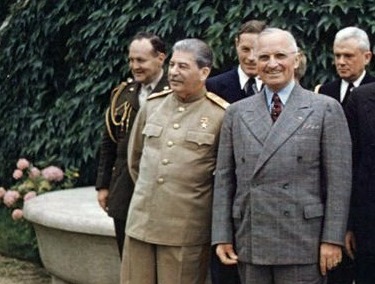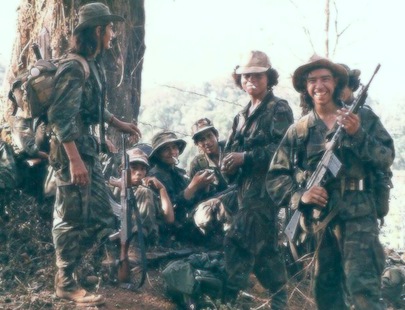The Cold War in 1,000 Words
Dan Bryan, March 7 2012
 Harry Truman and Joseph Stalin pose for a photo at the Potsdam conference in 1945. Can you tell which one is which?
Harry Truman and Joseph Stalin pose for a photo at the Potsdam conference in 1945. Can you tell which one is which?The United States and the Soviet Union were allies during World War II, but it was an alliance of convenience. With the threat of fascist domination removed, it did not take long for the inevitable fissure between these two systems to materialize. The overriding disagreement was always whether certain countries would be communist or capitalist in their system of government and economics. Between 1945 and 1991, this competition was the dominant feature of international politics, eventually ending in total victory for the United States.
Truman and Stalin
For the first year after World War II, the Soviet Union and the United States were in agreement that Germany must be turned into an agrarian, pastoral state, and they began to implement the Morgenthau Plan. After chaos and near starvation took hold, the United States repudiated this plan and eventually replaced it with the Marshall Plan.
Massive amounts of economic aid flowed into Germany, infuriating Stalin and the Soviet Union. He refused to allow any aid into eastern Europe, and he overthrew the Czech government when they attempted to act counter to this policy. The US, in fear of another world war, established NATO immediately thereafter, and a standoff emerged.
The Truman Doctrine guided United States actions for most of the Cold War. After the massive Soviet advances in the late 1940s, containment of this expansion became the overriding American foreign policy concern. Thereafter, Harry Truman and his successors were largely successful at stopping further communist encroachment into the free world.
The Red Scare -- Espionage and McCarthyism
In the first years of of the Cold War, there was a near frenzy about the possibility of Communist infiltration into the United States. Paranoia about espionage only increased when the Soviet Union managed to detonate a nuclear bomb in 1949 -- much earlier than any intelligence analyst thought possible. Joseph McCarthy's infamous hearings took place shortly thereafter, and the Rosenberg couple was famously executed for espionage in 1953.
The long-term effects of the Cold War on American government were immense. First and foremost, it led to the permanent creation of a peacetime defense and armaments industry, as President Eisenhower noted in his farewell address. It forced the United States to adopt a much more international outlook on world affairs. Prior to World War II, the Republican Party had been a staunch advocate of isolationism, and this reflected the mood of their constituency.
Throughout the 1950s and 1960s, the House Un-American Activities Committee was in operation, surveying the American cultural landscape for signs of disloyalty and potential communist espionage. This Committee became a favored target of leftists and intellectuals, particularly in the late 1960s.
The social effects are more difficult to quantify. For a time at the beginning of the Cold War, a more socially conservative culture did take hold than that which was seen before or after. How much of this was a direct result of the Cold War is impossible to determine. Examples of this culture can be found in the music and movies that were popular at the time. While many actors and directors with socialist or communist sympathies were being blacklisted from Hollywood, openly conservative performers such as John Wayne were enjoying their greatest successes.
The Cold War in action -- Proxy wars around the globe
 A group of "Contras" rest in Nicaragua, 1987
A group of "Contras" rest in Nicaragua, 1987The proxy battles in the Cold War were numerous. Here are some key locations and the events which transpired in them:
Greece (1946-1949) - fought between pro-western government, and communist guerrillas supported by the communist states of the Balkans. After 60,000 were killed in the fighting, the government maintained control and later joined NATO. One of the first testing grounds for Marshall Plan aid.
China (1949) - overthrow of government by Mao Zedong. Over the ensuing years, many ingenuous policies would be enacted, such as the Great Leap Forward, in which the peasantry of China was summoned to build blast furnaces in their yards and produce steel. Overall production lagged behind that of other industrialized nations. China and the Soviet Union, in spite of both being communist, were not on friendly terms for most of this time.
Korea (1950-1953) - stalemate between North and South Korea. The US and China joined the fight and about 750,000 people were killed by the end.
Iran (1953) and Guatemala (1954) - US backed coups installed repressive, pro-capitalist governments. Arguments still exit about the actual potential for either country to go fully communist, though both had very left-leaning governments.
Hungary (1956) - anti-communist uprising briefly overthrows the government. Soviets crush the rebellion, 2,500 killed.
Cuba (1959-1962) - Fulgencio Batista falls on New Year's Day. Cuba becomes a communist state on America's doorstep. Cuban Missile Crisis occurs in 1962 after Soviet attempts to make use of this new ally for missile bases.
Vietnam (1955-1975) - Long war between North and South Vietnam, with US assisting the south. Country unified under Communist rule. At least 3 million killed.
Dominican Republic (1965) - US intervenes in Dominican Republic to forestall potential communist takeover. 6,000 or more killed.
Czechoslovakia (1968) - Second unsuccessful democratization attempt in this country. Suppressed by Soviets.
Chile (1973) - socialist Allende government overthrown with US support. Repressive Pinochet government is installed.
Afghanistan (1979-1988) - Soviet Union invades to consolidate communist control. In the ensuing eight year war, up to 2 million are killed.
Nicaragua (1980s) - US backs the "contras" in their struggle against the socialist Sandinista government.
El Salvador (1980s) - US backs military dictatorship in battle with socialist insurgents. 75,000 killed.
Collapse of the Soviet System, and a "New World Order"
Serious strains to the Soviet system emerged by the late 1980s. Sustained economic stagnation led to massive dissatisfaction, especially in the satellite states. Strikes and protests became more frequent. The Soviet Union itself was full of annexed "Soviet Republics" with ethnic minorities who disliked the Russian hegemony.
Poland was the first to rebel, in 1989, and it soon became clear that Soviet Union was unable or unwilling to intervene militarily, as they traditionally had in eastern Europe. When Poland was allowed to overthrow the Soviet system, the effects were immediate. Other countries rejected the communists in quick succession. The odious Berlin Wall was torn down by a mob in 1990. The Soviet Union itself fractured and collapsed in 1991.
Many conservatives in the United States credit the unbending rhetoric and strong defense policies of Ronald Reagan for having an effect on this. This might have been the primary cause, or it might have been irrelevant. In an intertwined world, it's difficult to say.
Many in the United States looked forward to a new era of international peace and cooperation, typified at the highest levels by George Bush's "New World Order" speech -- a speech which continues to be a target of conspiracy theorists to the present day.
While the world is a drastically more peaceful place today than it was during the height of the Cold War, experience has shown that new problems will always emerge to replace old ones.
Recommendations/Sources
- Victor Sebestyn - Revolution 1989: The Fall of the Soviet Empire
- David McCullough - Truman
- John Lewis Gaddins - We Now Know: Rethinking Cold War History (Council on Foreign Relations Book)
- William Blum - Killing Hope: U.S. Military and C.I.A. Interventions Since World War II--Updated Through 2003
